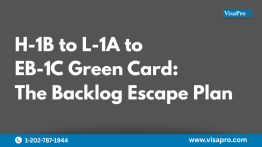Two interim final rules, one published by the Department of Homeland Security (DHS) and another by the Department of Labor (DOL), provide for significant changes to the H-1B Visa program. Some of the key changes proposed in the rules are as below.
DHS Regulations
- Revising the definition of and standards for a “specialty occupation” – The new rule clarifies that there must be a direct relationship between the required degree field(s) and the duties of the position. A position would not qualify as a specialty occupation if attainment of a general degree, without further specialization, is sufficient to qualify for the position. The petitioner will have the burden of demonstrating that there is a direct relationship between the required degree in a specific specialty and the duties of the position. The new rule is also amending the criteria for specialty occupation positions.
- Adding definitions for “worksite” and “third-party worksite” – “Worksite” is defined as the physical location where the work is actually performed by the beneficiary and “third-party worksite” is defined as a worksite, other than the beneficiary’s residence in the U.S., that is not owned or leased, and not operated, by the petitioner. The new rules provide that the beneficiary’s worksite will be a relevant factor in determining whether an employer-employee relationship exists.
- Clarifying “third-party worksite” engagements – The new rule clarifies the types of corroborating evidence petitioners must submit in third-party placement cases. Petitioners must submit evidence such as contracts, work orders, client letter, or other similar evidence to establish that the beneficiary will perform services in a specialty occupation at the third-party worksite(s), and that the petitioner will have an employer-employee relationship with the beneficiary. The rule also sets a 1-year maximum validity period for all H-1B petitions in which the beneficiary will be working at a third-party worksite.
- Clarifications on “employer-employee relationship” determination – The new rule restores, with additional clarification, a 2010 Policy Guidance regarding the employer-employee regulation that provided the factors that USCIS officers should consider when adjudicating H-1B petitions. The Policy Guidance was recently rescinded per an agreement with USCIS by a judicial ruling on procedural grounds.
- Codifying USCIS’ H-1B site visit authority – The new rule adds regulations specific to the H-1B program to codify the DHS’ existing authority to conduct inspections, clarify the scope of inspections, and consequences of refusal or failure to fully cooperate with the inspections.
The DHS interim final rule proposing these amendments will become effective on December 7, 2020, and will only apply to H-1B petitions filed on or after 12/07/2020, including H-1B amendment and H-1B extension petitions.
DOL Regulation
The DOL is amending regulations governing the prevailing wages for H-1B, H-1B1, E-3 workers, as well as for employment-based immigrants. The new rule amends DOL’s regulations relating to the methodology it will use to determine prevailing wages job opportunities in the H-1B, H-1B1, E-3, and permanent labor certification programs, and reflects the new wage level computations DOL will use to determine prevailing wages in the H-1B, H-1B1, E-3, EB-2, and EB-3 classifications and specifies the manner in which the wage levels are to be now calculated. The amendments are expected to lead to significant increases in the prevailing wage for PERM and H-1B filings.
The DOL interim final rule goes into effect on October 8, 2020.
VisaPro continues to monitor the situation closely and will provide further updates as the situation develops.
If you have any questions regarding the H-1B visa program, or need help filing for an H-1B or Green Card, contact VisaPro Law Firm today. Our experienced immigration attorneys will be happy to assist you.




